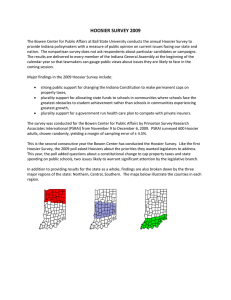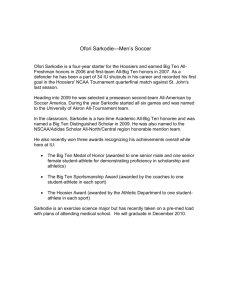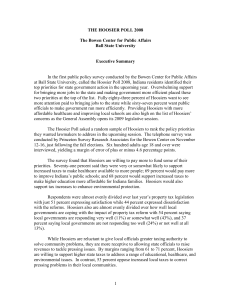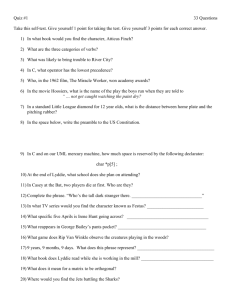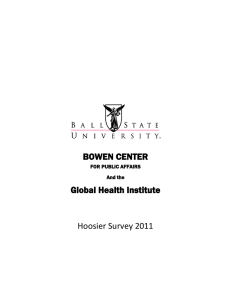BOWEN CENTER Hoosier Survey 2010 FOR PUBLIC AFFAIRS
advertisement
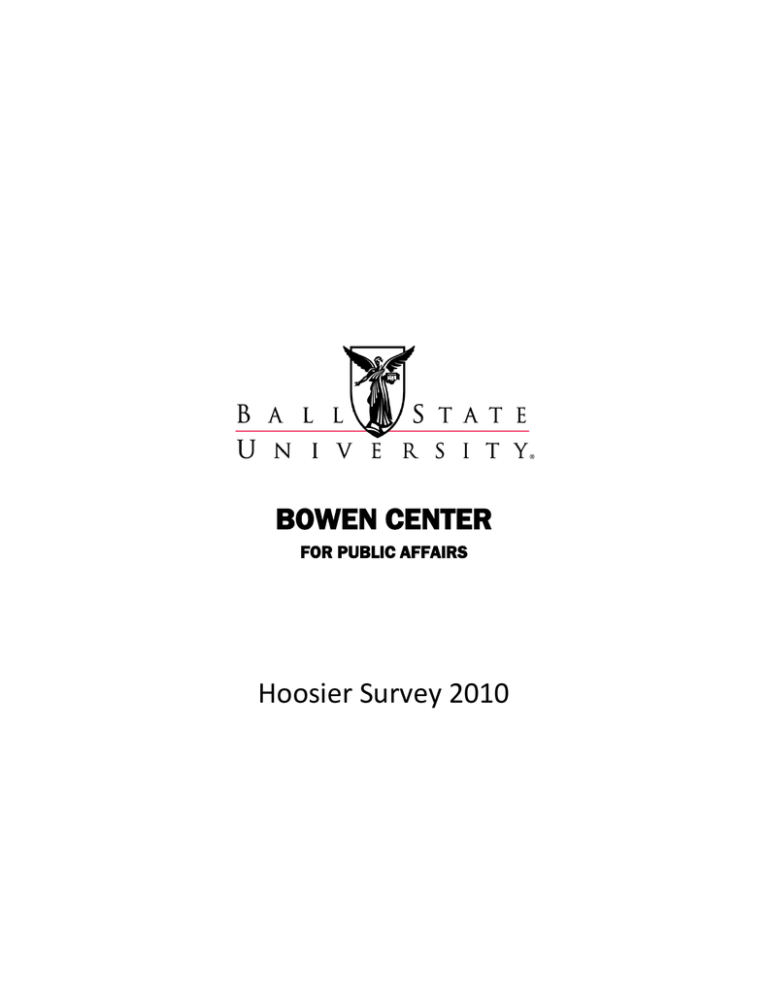
BOWEN CENTER FOR PUBLIC AFFAIRS Hoosier Survey 2010 THE HOOSIER SURVEY 2010 The Bowen Center for Public Affairs Ball State University Executive Summary In the third annual Hoosier Survey conducted by the Bowen Center for Public Affairs at Ball State University, Indiana residents identified their top priorities for state government action in the upcoming year. As was the case in last year’s Hoosier Survey, respondents overwhelmingly (77%) believe job creation is the number one state priority. This figure is up from 73% last year. Improving government efficiency finished second (61%) just ahead of improving schools (58%). Affordable health care was next (52%), down from number two last year. Other priorities with diminishing support include reducing illegal immigration (46%) protecting the environment (32%) and improving public transportation (17%). With property tax cuts now in place, Hoosiers were asked about their perceptions of local government services; whether they have worsened, stayed about the same, or improved. In all major areas, such as road maintenance, schools parks and recreation, sewage/water, and fire services, Hoosiers think services have stayed about the same. As the property tax caps continue to take full effect we will track reactions to these services in future years. We also asked about choosing between future service cuts versus tax increases. Majorities support higher taxes (with qualifications) in three areas: fire services (58%), schools (55%) and police (50%). Our 2009 Hoosier Survey showed that the willingness to pay additional taxes is closely correlated with government officials being able to clearly explain the exact needs for additional revenue along with identifying the specific projects or programs that will be funded. We asked about school funding, specifically about which schools should be given priority. Forty-four percent of Hoosiers believe that schools in communities facing the greatest obstacles to learning should have a higher funding priority than schools in communities experiencing the greatest growth (27%). Fourteen percent say that both types of schools should receive equal funding. Results are consistent across all regions of the state. These figures are very close to those found in our 2009 Hoosier Survey. With increased attention given to charter schools, we asked Hoosiers if they supported creating more charter schools. By nearly a two-to-one margin, respondents prefer to not create more charter schools but use those funds to support current public schools. For households with children in public schools, we asked about their level of satisfaction with public education. Respondents are overwhelmingly pleased (very satisfied or somewhat satisfied) with their local public schools. The highest level of satisfaction was in Central Indiana, with the lowest satisfaction level in Northern Indiana. Steps to improve education reveal that Hoosiers strongly recommend more parental involvement in schools (47%), with higher teacher salaries (20%) and tying teacher salaries to test scores (19%) finishing second and third. Closing failing schools attracted the support of only 13% of our sample. The state legislature will be addressing the issue of the unemployment insurance fund. Indiana has borrowed heavily from the federal government to support claims during the economic downturn and Governor Daniels has suggested combining benefit cuts with raising employer contributions. Our survey found substantial support for this approach while opposing more borrowing. The legislature also will be drawing new congressional and state legislative districts. We asked Hoosiers if they would like to see a nonpartisan commission draw the districts or if they would prefer keeping the process as it is, i.e., having the General Assembly draw the maps. Thirtyeight percent prefer a nonpartisan commission while 48% want to keep the current process. When asked their views on what factors should be considered in drawing the new maps, 76% want the new districts to respect township and county boundaries and 75% want to keep adjacent communities together in the districts. Sixty-six percent would like to see house districts clustered inside of senate districts and, overall, 61% favor more compact districts. Vote Centers, which replace traditional precinct polling places, expire this year. Nearly twothirds (63%) of Hoosiers support the idea of extending Vote Centers statewide, with 32% opposed and 5% unsure. Support for Vote Centers is consistent in all three areas across the state. The Tea Party movement nationally received considerable attention in 2010. We asked Hoosiers the extent to which they agreed or disagreed, or had no opinion at all, with the Tea Party movement. Nearly half of Hoosiers (46%) have no opinion either way about the Tea Party, with 32% saying they agree or strongly agree with the movement and 20% saying they disagree or strongly disagree. There are no substantial differences in the three regions of the state. Governor Daniels enjoys a relatively high approval rating, with considerable regional variation. Central Indiana respondents register a 59% approval of the Governor, with 47% in southern Indiana and 42% in northern Indiana. Southern Indiana holds the highest approval rating for the Indiana General Assembly at 57%, with 49% approval in central Indiana and 41% in northern Indiana. We asked questions centering on two national issues, extending the tax cuts enacted under former President George W. Bush, and healthcare reform recently enacted under President Barack Obama. Thirty-eight percent of Hoosiers would like to see the tax cuts extended to all groups of Americans. Close behind at 37% are those saying the cuts should be extended only for those making less than $250,000 a year, and 13% say the cuts should expire for everyone. Twelve percent had no opinion. On healthcare, 50% of Hoosiers have an unfavorable view of the reform act, with 35% favorable. When asked about some of the important specific provisions, however, Hoosiers have a favorable opinion, with 95% agreeing with making insurance coverage affordable, 91% agreeing that persons should not be cancelled from insurance because of preexisting conditions, 78% agreeing that everyone should be covered, and 66% agreeing with keeping children on family policies until age 26. The Hoosier Survey was conducted by the Bowen Center for Public Affairs in conjunction with Princeton Research Associates International of Princeton, NJ. The survey was conducted by telephone, both cell and landline, among a random sample of Hoosier adults over the age of 18 from November 9-18. Six hundred respondents completed the survey, yielding a margin of error of plus or minus 4.7 percentage points. The following provides a more detailed analysis of these results with additional breakdowns by the three regions of the state. This information and more are available on the website of the Bowen Center for Public Affairs at www.bsu.edu/bowencenter. For additional information, contact: Dr. Raymond H. Scheele, Co-Director, The Bowen Center for Public Affairs 765-285-8982. rscheele@bsu.edu. Dr. Sally Jo Vasicko, Co-Director, The Bowen Center for Public Affairs 765-285-8982. svasicko@bsu.edu. Dr. Joseph Losco, Chair, Department of Political Science, Ball State University 765-285-8780. jlosco@bsu.edu. HOOSIER SURVEY 2010 The Bowen Center for Public Affairs at Ball State University conducts the annual Hoosier Survey to provide Indiana policymakers with a measure of public opinion on current issues facing our state and nation. The nonpartisan survey does not ask respondents about particular candidates or campaigns. The results are delivered to every member of the Indiana General Assembly at the beginning of the calendar year so that lawmakers can gauge public views about issues they are likely to face in the coming session. Major findings in the 2009 Hoosier Survey include: An overwhelming majority (77%) of Hoosiers believe the number one priority for the state should be job creation while increasing government efficiency is close behind. Hoosiers would be willing to pay more for some services like fire protection and schools but prefer cuts in service to tax hikes in other areas like jails, parks, and government operations. Hoosiers want more parental involvement in the public schools and would rather have tax money go to investing in public schools than to creating more charter schools. Hoosiers do not look favorably upon the new federal healthcare reform law but they do like many of the provisions it ushers in. The survey was conducted for the Bowen Center for Public Affairs by Princeton Survey Research Associates International (PSRAI) from November 9-18, 2010. PSRAI surveyed 600 Hoosier adults, chosen randomly, yielding a margin of sampling error of ± 4.7%. This is the third consecutive year the Bowen Center has conducted the Hoosier Survey. Like the first two, the 2010 poll asked Hoosiers about the priorities they wanted legislators to address. This year, the poll added questions about ways to improve schools, support for the new healthcare reform law, the Bush era tax cuts, reapportionment, and funding the state’s unemployment trust fund. In addition to providing results for the state as a whole, findings are also broken down by the three major regions of the state: Northern, Central, and Southern. The maps below illustrate the counties in each region. Major Findings Policy Priorities for the State As in our surveys over the previous two years, job creation remains the top priority for Hoosiers with 77% saying the state needs to do more to bring jobs to the state even though a majority of Hoosiers (52.4%) are either very satisfied or somewhat satisfied with the record the state has built in creating jobs. Other top priorities include making government run more efficiently (61%), improving schools (58%), and making healthcare more affordable (52%). This year government efficiency and school improvement leapfrogged healthcare in the ranking of priorities. Only one regional difference occurred in the rankings with school improvement slightly edging increased government efficiency for second place in the southern counties of the state. Top Priorities for the General Assembly 90% 80% 70% 60% 50% 40% 30% 20% 10% 0% 77% 61% 58% 52% 46% 32% 17% 2010 2009 Assessing Government Services Since the legislative approval of property caps, many local governments have found it necessary to freeze or make cuts in spending for local government services. How have Hoosiers reacted? Do they perceive these services to have worsened, stayed about the same, or perhaps even improved despite the caps? Overall, Hoosiers have not noticed a difference in service delivery, although road maintenance and schools were perceived as growing worse by almost a quarter of our respondents. There were no significant differences in these results reported by region. Assessing Government Services 70% 60% 50% 40% 30% 20% 10% 0% 42.00% 32% 64% 57% 55% 42% 26% 21% 17.00% 12% Improved Worsened Stayed Same Support for Future Cuts or Tax Increases We questioned Hoosiers about their choices for future service cuts versus tax increases. Majorities told us they would support higher taxes in three areas: fire, schools, and police. However, between a quarter and a third of respondents were unsure about which options they would support. Hoosiers appear to be providing legislators wide latitude regarding taxes and service cuts. Taxes or Cuts? (Includes Unsure) 70% 58% 60% 50% 40% 30% 20% 10% 0% 55% 50% 41% 29% 24% 15% Increase Taxes Reduce Services Not Sure Schools Since the state assumed the principal role in funding the public schools, there has been substantial discussion regarding the formula the state should adopt in allocating funds. Some have argued that funding should go to communities facing the greatest growth in school attendance while others have suggested that schools facing the greatest obstacles to student achievement should garner more funds. These might be schools in communities with high rates of poverty. Consistent with 2009 survey results, Hoosiers favor giving more funds to schools in communities facing the greatest obstacles to student achievement than to schools facing the greatest growth. As with last year’s survey, these results are consistent across all regions of the state. Priority for School Funding Statewide 50% 45% 40% 35% 30% 25% 20% 15% 10% 5% 0% 44% 45% 33% 27% 14% 9% Communities with greatest growth Schools with Same priority students facing OTL 15% 13% 2010 2009 DK This year, we also asked about public support for charter schools. Hoosiers told us they would prefer not creating new charters but instead using that money to help support current public schools. Once again, there was remarkable consistency across the state. Fund Current Schools Rather Than Create New Charters 80% 69% 70% 69% 65% 60% 50% Create more charters 40% 28% 24% 30% Use money for current schools 21% 20% 10% 0% Northern Central Southern Next, we asked those respondents with children in public school grades K though 12 in the school year that ended in May (about one quarter of our sample) how satisfied they were with the quality of education their children were receiving. Results were overwhelmingly positive with nearly 80% being very satisfied (42%) or somewhat satisfied (37%). Respondents with children in the central counties yielded the highest percentage of “very satisfied” responses (49%), while just 27% of those in the northern counties gave the same response. Satisfaction with Public Schools (Those with Children Attending) 60% 50% 49% 45% 38% 40% 30% 51% 27% 29% Northern Central 20% 13%11%13% 10% Southern 8%9% 3% 0% Very Satisfied Somewhat Satisfied Not very satisfied Not at all satisfied Finally, we asked all respondents their priorities for improving public education. By a wide margin, Hoosiers said their first choice would be to improve parental involvement with the schools. Increasing teacher salaries and tying teacher salaries to student test scores nearly tied for second place. Fewer than 8 percent preferred closing failing schools. Rank ordering was consistent across the state. However, a higher percentage of Hoosiers in the northern counties favored closing underperforming schools (13%) than respondents in central (3%) or southern counties (9%). Preferences for Improving Education 47% 50% 45% 40% 35% 30% 25% 20% 15% 10% 5% 0% 20% 19% 8% 6% Unemployment Insurance An issue the General Assembly will face is the unemployment insurance shortfall. The trust fund has borrowed heavily from the federal government to support claims during the current economic downturn. Governor Daniels has suggested addressing this shortfall by combining benefit cuts with raising employer taxes. Our survey found substantial support for this approach while opposing more borrowing from the federal government. Addressing Unemployment Fund 70% 60% 50% 40% 58% 55% 48% Increase Employer Contributions 44% 38% 33% Limit Eligibility/Benefits 30% Continuing to Borrow 20% 9% 8% 7% 10% 0% Favor Oppose DK Reapportionment The 2011 Indiana General Assembly is responsible for drawing new lines for the Indiana Congressional districts, the Indiana State Senate and the Indiana House of Representatives. We asked about the various factors that should be used in redistricting. Some states (e.g., California, Iowa) employ nonpartisan bodies to remove political factors in the reapportionment process. Such an approach was advanced by former Secretary of State, Todd Rokita. He also outlined several features of map drawing to improve the integrity of district configuration. Our survey found support for the principles he outlined but little support for changing the current partisan method. The results were consistent across the state, although support for keeping the current process in place was slightly stronger in southern counties. Redistricting Process 60% 48% 50% 38% 40% 30% 20% 14% 10% 0% Nonpartisan Commission Keep Current Process DK/NA Factors in Redistricting 80% 70% 60% 50% 40% 30% 20% 10% 0% 76% 75% 66% 61% More Compact Districts Cluster House within Senate Dist. Adjacent CommunitiesTogether Respect Twnshp/County Borders Vote Centers Vote Centers, which replace traditional precinct polling places, expire this year unless the General Assembly renews them. Three counties, Cass, Tippecanoe and Wayne have used Vote Centers over the past three years. Studies have shown that in the three pilot counties voters were very satisfied with Vote Centers and the operation of Vote Centers saved significant amounts of money in election administration. Hoosiers strongly support the idea of extending Vote Centers statewide. Nearly twothirds (62.9%) support the idea, with 31.6% opposed and 5.5% unsure. Support was consistent across all regions of the state. Tea Party in Indiana Given the wide notoriety of the national tea party movement, we asked Hoosiers whether or not they agreed with the movement. The following chart shows the responses from our Hoosier Survey (HS) as compared to a recent (Oct. 2010) national survey by PEW Research. HS PEW1 Strongly Agree Agree 10% 22% 12% 8% 46% 2% 17% 11% 14% 32% 14% 12% Disagree Strongly Disagree No Opinon Either Way DK/NA Similar to PEW’s national survey of registered voters, a solid plurality of Hoosiers has “No Opinion Either Way” about the Tea Party Movement. There were no substantial regional differences in the Hoosier Survey results. Some Indiana counties had tea party organizations and there were some scattered tea party “rallies” around the state during the 2010 election. 1 Source: PEW Center for People and Press, Nov. 2010 Post Election Survey. Approval Ratings Governor Daniels maintains majority support among all Hoosiers, but there is strong regional variation. Gov. Daniels Approval 70% 59% 60% 50% 40% 47% 42% 35% 30% Approve 31% 25% 23% 22% DK/NA 16% 20% Disapprove 10% 0% Northern Central Southern The overall rating for the General Assembly dipped slightly from last year; but, once again, there were significant regional differences with the highest approval rating in the southern counties. General Assembly Approval 57% 60% 49% 50% 41% 40% 30% 32% 32% Approve 27% 24% 19% 20% Disapprove 19% DK/NA 10% 0% Northern Central South National Issues We polled on two national issues of importance at this time: extension of the Bush era tax cuts and views on the recently enacted healthcare reform measure. Bush Era Tax Cuts With regard to extending the Bush era tax cuts, Hoosiers are fairly evenly divided with regard to whether the tax cuts should be extended to all taxpayers or only for those who make $250,000 or below. A recent PEW survey2 of registered voters nationally found a similar breakdown with regard to the first two choices, although a larger percentage of national respondents indicated they would prefer the tax cuts to expire for everyone. Hoosier Survey Extend Tax Cuts for ALL: 38% Tax cuts only for those making $250 K or below: 37% Allow cuts to expire for all: 13% DK 12% PEW 34% 30% 28% 8% While there are some regional differences, they are not statistically significant. Bush Era Tax Cuts 50% 45% 40% 35% 30% 25% 20% 15% 10% 5% 0% 42% 39% 33% 43% 36% 30% Northern 16% 11% 12% Continue Cuts Continue Only Allow Cuts to for All for Below Expire for All $250K 16% 13% 9% Central Southern DK Healthcare Reform The Obama administration’s healthcare reform law has garnered much vocal opposition nationwide and spurred action by Attorney’s General and candidates for Congressional office to repeal it. Hoosiers have a slightly more negative view of the new law than a national sample of voters polled by PEW Research3, 50% as opposed to 45% nationally; but the percentage expressing favorable views is quite similar, 35% in our poll as opposed to 38% in the PEW survey. Regional differences in our survey were not statistically significant. 2 PEW Center for People and Press, Nov. 2010 Post Election Survey . 3 Ibid. Views on Healthcare Reform 60% 50% 50% 40% 35% 30% 20% 12% 10% 3% 0% Favorable Unfavorable Mixed View DK Finally, we asked Hoosiers how important certain provisions of the new reform law were to them. Generally, we found high approval for several particular provisions of the reform law even while a majority of Hoosiers did not favor the overall bill. Important Ingredients for Healthcare Reform 100% 90% 80% 70% 60% 50% 40% 30% 20% 10% 0% 95% 91% 78% 66% 32% 18% 4% Making coverage affordable 5% Ensure Prohibit Keep children coverage for cancelation for on parents' everyone preexisting insurance 'til conditions 26 Important Unimportant
